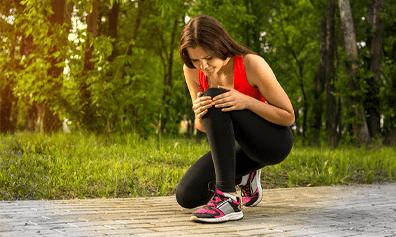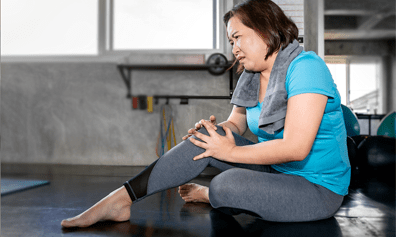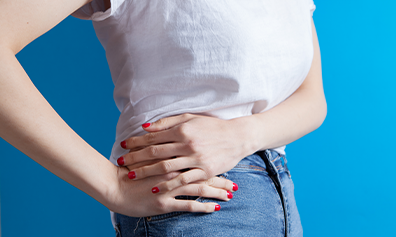
What is Hip Bursitis?
A bursa is a closed fluid-filled sac that functions as a gliding surface to reduce friction between body tissues. When a bursa becomes inflamed, the condition is known as "bursitis."
There are two major bursae of the hip, the trochanteric bursa, and the ischial bursa. These are located adjacent to the edges of the femur (thighbone) and pelvic bone, respectively. Inflammation of either can be associated with stiffness and pain around the hip joint. The trochanteric bursa is located on the side of the hip. It is separated significantly from the actual hip joint by tissue and bone. Bursitis is not arthritis and, therefore, is not a cause of real joint pain.
Why does it happen?
Most commonly, bursitis is a non-infectious condition (aseptic bursitis) caused by inflammation that results from local soft-tissue trauma or strain injury. On rare occasions, the hip bursa can become infected with bacteria. This condition is called septic bursitis. Although uncommon, the hip bursa can become inflamed by crystals that deposit from that place gout, pseudogout, or calcinosis as a result of scleroderma.
What does it feel like?
Trochanteric bursitis has the following symptoms:
- • Pain and tenderness of the outer hip and thigh, making it difficult for those affected to lie on the involved side
- • Difficult sleeping due to pain.
- • Dull, burning pain on the outer hip and thigh often worsens with excessive walking, exercise, or stair climbing. .
- • Iliotibial band syndrome can sometimes mimic or be associated with trochanteric bursitis.
Ischial bursitis has the following symptoms:
- • The ischial bursa is located in the upper buttock area. Ischial bursitis can cause dull pain in this area that is most noticeable when climbing uphill.
- • The pain sometimes occurs after prolonged sitting on hard surfaces, hence the names "weaver's bottom" and "tailor's bottom."
What are the risk factors of Hip Bursitis?
Risk factors for hip bursitis include activities that could strain the hip area, including going up and downstairs, repetitive activities such as stair-climber exercising, etc.
How do you differentiate it from other hip problems?
The differential diagnosis for trochanteric bursitis includes snapping hip syndrome (iliopsoas tendinitis), fracture of the greater trochanter, femoral neck, or intertrochanteric hip fracture, a hamstring avulsion injury, or simple muscle strain or sprain.
Special orthopedic tests, radiographs, and the signs and symptoms help with differential diagnosis of hip bursitis.
How much time does it take to heal?
The time it takes to heal the condition varies, but results can be achieved in 2 to 8 weeks or less when a proper stretching and strengthening program is implemented.
How do you manage it?
Bursitis generally gets better on its own. Conservative measures, such as rest, ice, and taking a pain reliever, can relieve discomfort. If traditional measures don't work, you might require:
- • Medication - If an infection causes inflammation in your bursa, your doctor might prescribe an antibiotic.
- • Therapy - Physical therapy or exercises can strengthen the muscles in the affected area to ease pain and prevent recurrence.
- • Injections - A corticosteroid drug injected into the bursa can relieve pain and inflammation in your shoulder or hip. This treatment generally works quickly, and, in many cases, one injection is all you need. .
- • Assistive device - Temporary use of a walking cane or another device will help relieve pressure on the affected area.
- • Surgery - Sometimes, an inflamed bursa must be surgically drained, but only rarely is the surgical removal of the affected bursa necessary.
What exercises can I perform to get relief from Hip Bursitis?
The following exercises are strongly recommended to find relief from hip bursitis pain:
1.Hip bridges
- • Hip bridges engage your hip flexors, glutes, hamstrings, and quadriceps.
- • All of these muscles play a role in supporting the hip joints, making this exercise perfect for hip strength.
- • Start by lying flat on your back with your feet flat on the ground close to your bottom and your legs bent.
- • In a controlled motion, drive your weight down through your heels to elevate your hips up, so they're in line with your shoulders and knees..
- • You should feel this upward driving motion primarily in your glutes and hamstrings.
- • Sink your hips back down to the ground slowly.
- • Perform 5 sets of 20 repetitions..
You can increase the challenge of hip bridges by completing 5 "until failure" sets.
- • Perform the hip bridge as described above.
- • Be sure not to compromise your form as the repetitions get more challenging.
- • Complete 5 sets. In each set, go until you can’t do another rep.
- • You can add a weight and sit it on your pelvis to increase the difficulty.
2.Lying lateral leg raises
- • Lying lateral leg will help strengthen and develop your tensor fasciae latae (TFL) and iliotibial band (ITB), which spans the outside portion of your upper leg.
- • This vascular band is partially responsible for side-to-side leg motion. It often gets neglected in a running routine since the running stride is forward and backward. Thus, it's pertinent to spend some time enhancing the stability and strength it provides.
- • To perform this exercise, lie on your right side with your right arm extended out for balance.
- • Lift your leg as far as you can extend it, trying to achieve the greatest range of motion possible.
- • In a controlled motion, bring your left leg back down so that it's in line with your right leg.
- • Complete 15 repetitions with that leg, then roll over onto your left side and perform 15.
- • Finish 3 sets of 15 repetitions on each leg.
- • Lying on your side can irritate hip bursitis. If this position irritates you, try putting a pillow or foam mat between the floor and your hip joint. If this is still irritating, you can perform this exercise standing.
3.Lying leg circles
- • Performing lying leg circles will help promote the range of motion, flexibility, and strength in all of the small muscles that make hip and leg rotation possible.
- • Start by lying flat on your back with your legs extended.
- • Elevate your left leg to about 3 inches off of the ground, and then make small circles, keeping your whole leg straight and in line.
- • Switch to your right leg and perform the same movement.
- • Perform 3 sets of 5 rotations on each leg for 30 total reps on each leg.
- • For the best results, look to incorporate these exercises four to five times a week. Boosting the strength of your hip and leg muscles will undoubtedly minimize the risk of developing bursitis and may help with the pain associated with hip bursitis.
How do you prevent it?
Other measures you can take to relieve the pain of bursitis include:
- • Rest and don't overuse the affected area.
- • Apply ice to reduce swelling for the first 48 hours after symptoms occur.
- • Apply dry or moist heat, such as a heating pad or taking a warm bath.
- • Take over-the-counter medication to relieve pain and reduce inflammation. Some are available in a form you apply to the skin.
- • Cushion your knees if you sleep on your side by placing a small pillow between your legs.
Telehealth to Your Rescue
During these times of global pandemic, it can be challenging to find the help you need to maintain your joint health. But with telerehabilitation services, you can get the benefits of physical therapy from the comfort of your home without worrying about exposure or transport.
TheraNow, one of the best telerehabilitation services with excellent expertise in the field of physical therapy, with our team of virtual physical therapists who are waiting to provide you the care you need to get your life back in its happy place. You can book your appointment by visiting us at Theranow: Online Physical Therapy Services
































































